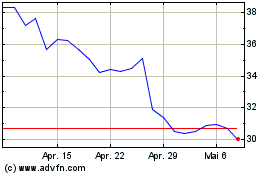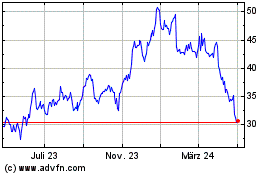Intel to Cap Off Difficult Year Ahead of New Chief
21 Januar 2021 - 2:29PM
Dow Jones News
By Asa Fitch
Intel Corp. is poised to post full-year results that outline the
breadth of challenges awaiting the incoming chief executive as the
chip maker looks to fend off competitive pressures and rebuild its
technological leadership.
The earnings Thursday afternoon mark the end of a challenging
yet lucrative year for the semiconductor giant that saw it
surpassed in market valuation by rival Nvidia Corp., dropped by
Apple Inc. as a supplier for Mac chips, suffer market-share losses
and face activist investor Third Point LLC pushing for strategic
changes.
Wall Street expects the semiconductor giant to report record
full-year revenue of $75.4 billion, up from $72 billion the year
prior. But analysts surveyed by FactSet foresee lower sales this
year, in part reflecting a pair of divestitures and growing
competitive pressure. And while Intel has benefited from a boom in
demand for PCs in the work-from-home economy, much of the added
buying has focused on lower-cost laptops that aren't as profitable.
Net income for 2020 is expected to fall to $19.3 billion, from
$21.1 billion the year prior.
Intel's longer-term strategy around the outsourcing of chip
production is also in flux ahead of the arrival of Pat Gelsinger as
CEO. Bob Swan, the company's departing chief executive, said last
year that a decision was forthcoming by early this year on whether
to have the company's advanced chips made by a third party after
Intel fell behind Asian rivals in the development of the next
generation of superfast semiconductors.
The company is considering outsourcing production of some of its
most prized chips to those Asian rivals, and particularly to Taiwan
Semiconductor Manufacturing Co., the largest and most advanced
contract chip maker in the world, according to people familiar with
the matter.
Intel already has decided to send out production of coming
graphics-processing chips to TSMC, and the companies have been in
talks about deepening their relationship further. Mr. Swan visited
TSMC to discuss potential options in December, according to a
person familiar with the trip.
Intel declined to comment.
TSMC last year announced plans to build a chip factory in
Arizona, its second in the U.S. And the company last week said it
planned record capital expenditures of as much as $28 billion this
year, a huge increase from last year and an indication, in some
analysts' eyes, that new business from Intel is on the way.
Given the importance of that decision to Intel's long-term
future, a final verdict on outsourcing plans could be deferred
until Mr. Gelsinger takes over in mid-February, analysts say. The
selection of Mr. Gelsinger, the chief executive of VMware Inc., who
spent three decades at Intel earlier in his career, was widely
hailed. Intel's stock is up 10% since his naming. But analysts
expect the turnaround in an industry where product-development
cycles are measured in years, not months, to take time.
"It's a good thing to bring in someone new, and particularly
someone who has worked at Intel and has a tech background, but
whatever path they follow, it will take time to implement," Wedbush
Securities analyst Matthew Bryson said.
Third Point, the activist hedge fund led by Daniel Loeb, took a
position of about $1 billion in Intel's shares and advocated in a
December letter for the company to consider an even more
foundational change: splitting up its chip-design and manufacturing
operations. Such a move would end Intel's decadeslong run as the
leading U.S. integrated chip manufacturer. On Twitter, Mr. Loeb
praised Mr. Swan for stepping aside for Mr. Gelsinger.
Intel is facing other pressures, including from competitors such
as Nvidia and Advanced Micro Devices Inc. Amid Intel's
manufacturing setbacks, AMD has gained market share quickly in
central processors for PCs and servers.
When Intel announced Mr. Gelsinger's appointment last week, the
company pointed to strong progress on its next-generation chips,
which it previously disclosed were running a year behind their
initial schedule. The company also said it expected fourth-quarter
results to come in above guidance in October of about $17.4 billion
of revenue and $1.02 in earnings per share.
-- For more WSJ Technology analysis, reviews, advice and
headlines, sign up for our weekly newsletter.
Write to Asa Fitch at asa.fitch@wsj.com
(END) Dow Jones Newswires
January 21, 2021 08:14 ET (13:14 GMT)
Copyright (c) 2021 Dow Jones & Company, Inc.
Intel (NASDAQ:INTC)
Historical Stock Chart
Von Mär 2024 bis Apr 2024

Intel (NASDAQ:INTC)
Historical Stock Chart
Von Apr 2023 bis Apr 2024
